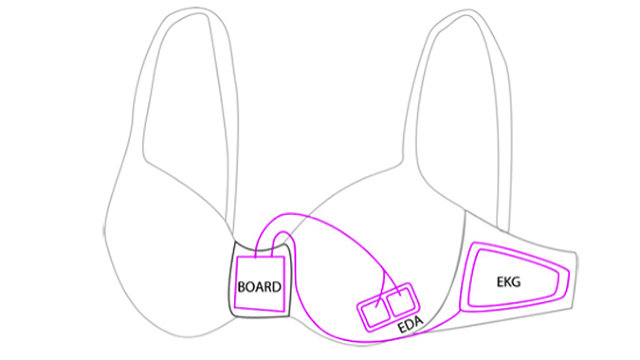Two weeks ago, Sony prompted guffaws all over the Internet when they unveiled their latest invention: SmartWig. Developed by Hiroaki Tobita and Takuya Kuzi, the SmartWig is basically an EEG interface glued to an artificial coiffure that can connect to a smartphone through Bluetooth.
That was bad enough, but as if to outdo their Japanese rival, Microsoft blew the SmartWig out of the water with an even more ridiculous patent called the Mood Bra. The patent essentially described an EKG attached to a bra, which also connects to a smartphone by Bluetooth. The company posits that it could be used to help women track their moods, thereby eliminating things like emotional overeating.

Sony's patent seems sort of silly--it is hard to imagine that the international Rogaine community has been clamoring for the wig to join the Internet of things--while at first blush, Microsoft's seems misogynistic, as if some frat bro researcher belched and said: "How about a device that connects to some fatty's smartphone and tells her when she's getting too emotional by feeling her boobs?"
Yet these patents aren't as absurd as they initially appear. Not only are both of these products plausible, there's also a chance that someday, Microsoft and Sony will be making money off of them. How? Welcome to the weird world of technology patents.

Outside of being strange ideas for consumer products, both Sony's SmartWig and Microsoft's Mood Bra have one big thing in common: they aim to take existing proven medical technology and find ways to commercialize it. In the SmartWig's case, Sony imagines a consumer EEG that can measure your brain waves by pressing a sensor against your scalp. With the Mood Bra, Microsoft has thought up a way to mass market an EKG by placing a sensor near your heart.
So Sony probably never started out by saying, "Let's make a wig with a computer inside." Likewise, no one at Microsoft ever said, "Let's make a smart bra." Rather, they started from the other side. Their researchers asked themselves what a consumer product using an EEG or EKG would be like, how people could be convinced to wear it, and what sort of functionality it would have given these constraints. A consumer EEG would, by its nature, need to be a hat, a headband, or a wig, where as an EKG would have to be something worn close to the heart.
A Mood Bra makes a lot more sense from this perspective. Women are already used to wearing garments across their chests, so a consumer EKG is easier to market to them. Likewise, such devices are designed to detect heart fluctuations, which happen at times of emotional stress. Why not make a bra, then, to help women keep track of their moods?

Coming at it from this direction, the Mood Bra is one of the most obvious products someone who wanted to mark a consumer EKG device could make. That doesn't mean, however, that Microsoft wants to actually make one, anymore than Sony wants to try to bring a SmartWig to market. In fact, companies patent things all the time they have no intention of making.
Here's an interesting example that helps to make the role of patents in the modern tech landscape clear. Despite the fact that Microsoft's mobile operating system, Windows Phone, is soundly losing the smartphone wars, Microsoft earns $2 billion a year off of Google's Android operating system. It does this by licensing hundreds of the various mobile-related patents it has amassed over the years to Google and Android handset makers. That's $2 billion a year Microsoft makes because, over the years, the company had the foresight to pay some egghead to sit around in the lab and dream up "ridiculous" products that could never possibly happen, then patent them.
Consider the smartphone. Back in the 1980s, if you told someone that we would one day be able to fit a computer the size of a deck of cards in our pocket that could not only store every movie, book, or song ever made, but wirelessly talk with every other computer on the planet, you'd be called a madman. But Microsoft filed a lot of patents imagining such a device, which is why they are now making billions off of losing the smartphone wars.
From that perspective, are Microsoft and Sony's latest patents really so ridiculous? Sensors are getting cheaper every day, and wearable technology is widely considered to be the next big frontier in technology. We might think they are ludicrous today, but 20 years from now, we might all be wearing SmartWigs or Mood Bras, or, at least, devices with similar implementations and functionality. This isn't madness, it's foresight.